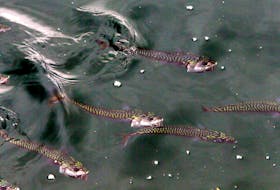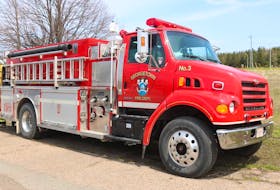Eight years ago on an April evening, BP’s Deepwater Horizon drilling platform in the Gulf of Mexico exploded, killing 11 workers, injuring 17 more and leaking nearly five million barrels of oil into the ocean off the U.S. coast.
The wellhead blowout — a combination of human error and mechanical and design insufficiencies — caused the largest oil spill in history, cost billions of dollars to mitigate, and some experts say resulted in irreparable damage to the surrounding ecosystem.
With BP now approved to drill up to seven deepwater exploration wells off the coast of Nova Scotia, some are wondering if the province is at risk of its own Deepwater disaster.
Antonia Juhasz, award-winning investigative journalist and author of Black Tide: the Devastating Impact of the Gulf Oil Spill, will be at Saint Mary’s University this week, along with Colin Sproul of the Bay of Fundy Inshore Fishers’ Association and Mi’kmaq activist Michelle Paul, to discuss that very issue as part of a speaking tour organized by the Council of Canadians.
“There are a lot of unique elements to this drilling that add to the risk,” Juhasz told The Chronicle Herald. “One is that BP’s proposal includes ultra-deepwater drilling at twice the depth of the well that they were drilling in the Gulf of Mexico.”
To put that into perspective, Juhasz said the Gulf of Mexico drilling was more than 1,500 metres, and some drilling proposed off Nova Scotia goes as deep as 3,000 metres.
“One of the best explanations I’ve had for what drilling deep water is like by a driller — he said it’s like driving a car from the back seat with a blindfold on and the more deep you go, the harder it is to see and to judge what’s happening,” she said.
“There’s no such thing as riskfree operations. It gets riskier and riskier deeper you go. The more complex the drilling.”
In her February decision approving the ScotianBasin exploration project, Environment MinisterCatherine McKenna said the drilling “is not likelyto cause significant adverse environmental effects,” but BP dares not make such a claim, said Juhasz. A section dedicated to
the Scotian Basin Exploration Project on BP’s webpage says only that the company plans to “manage and mitigate environmental impacts.”
And Juhasz said well blowouts are exceptionally common in deepwater drilling — it just means there is a loss of well control.
Since oil and gas appear together, exploratory drilling involves managing a very complicated balance of pressure, Juhasz said.
“The gas wants to escape faster than the oil,” she said. “There’s an intricate dance of trying to control the pressure of the well and the weight of the water bearing down on top.
“If you’re in a shallow-water drill site closer to shore, it’s not as deep, there’s less pressure, less distance between the rig and the well, and it’s much easier and quicker to control.”
The extent of damage caused by a blowout depends on a number of different factors, Juhasz said, but even a small one could be dangerous to both workers and the environment.
“In the case of the Deepwater Horizon, the blowout, the loss of well control, led to gas escaping up the pipe and into the rig, a spark igniting as a result of the gas entering the rig, and an explosion following the release of gas into the rig. And that explosion kicked off many other explosions.”
Juhasz said although BP said they knew how to contain a deepwater blowout, it became evident in the aftermath of the Gulf of Mexico disaster that they had not properly prepared for it.
“They were not taking this plan seriously,” she said. “They had done things like cut and paste an oil spill preparation plan from Alaska to the Gulf of Mexico.”
Sproul, a fifth-generation lobster fisherman, said the fishing industry is a huge economic boon for the province. Putting that in jeopardy, he said, is short-sighted.
“All it takes in the oil industry to have a catastrophic situation is one human error,” Sproul said. “A human error on a lobster boat does not generate a catastrophic environmental disaster that ends our industry and livelihood and the way of life that my ancestors have practised for hundreds of years.”
Sproul said it’s especially concerning for him that
the nearest capping stack — a piece of equipment that caps a well if a subsea blowout occurs — is in Norway and would take 12 to 19 days to reach Nova Scotia.
Though a capping stack is not the first line of mitigation in a well blowout, Sproul said taking two weeks to deploy one if it is needed is an unacceptable risk, especially considering other countries like Norway and the U.S. require companies to ensure much quicker capping times before approving a project.
Sproul also called BP’s proposed cleanup methods for the North Atlantic Ocean — skimmers to collect the oil and floating barriers called booms to contain a spill — ridiculous.
“Sometimes we have 100-foot sea states on the Scotian Shelf,” he said. “If any of them had ever been there in the wintertime, they know that will not work.”
Sproul and Juhasz will speak at Saint Mary’s University’s Scotiabank Theatre on Tuesday at 7 p.m.
In an emailed statement, a spokesperson from BP Canada said the company works diligently to avoid, minimize and mitigate environmental impacts.
The spokesperson said BP has developed detailed drilling plans in accordance with regulatory requirements and their own practices and procedures.
“Many response capabilities evolved since the Deepwater Horizon accident including significantly improved blowout preventers and the development of capping stacks,” the statement reads.
“We apply continuous improvement based on learnings from around the world. Our priority is to drill safely, and to prevent incidents from occurring.”








